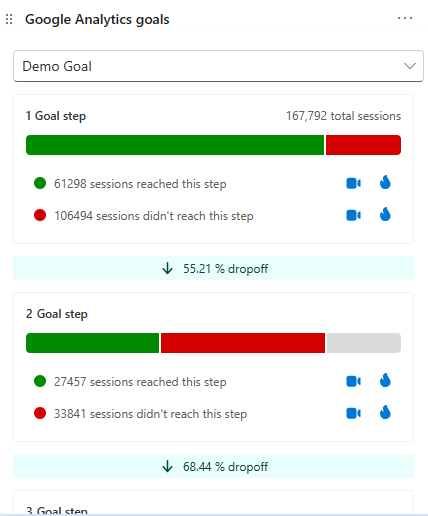What Data Is Google Analytics Goals Unable to Track and Why
What Data Is Google Analytics Goals Unable to Track and Why
Blog Article
Introducing the Blind Attractions: Comprehending What Google Analytics Goals Can not Measure
In the world of electronic analytics, Google Analytics stands as an effective tool for monitoring and examining on-line individual interactions. Comprehending what Google Analytics objectives can not gauge is critical for gaining an extensive view of customer behavior and involvement.
Individual Habits on External Platforms
Comprehending how individuals interact on exterior systems is critical for enhancing on the internet strategies. Outside platforms, such as social networks networks, reference sites, and on the internet forums, play a significant role in driving website traffic to a business's internet site. By examining individual habits on these platforms, organizations can get useful insights into the efficiency of their advertising initiatives and the preferences of their target market.
One key aspect of individual actions on outside platforms is the reference source. By tracking where the individuals are originating from, businesses can determine which platforms are driving the most traffic to their site. This details can aid companies assign their resources a lot more effectively, concentrating on the platforms that produce the most effective results.

Offline Conversions and Interactions
Evaluating user actions on exterior systems offers beneficial insights right into online techniques; however, thinking about offline conversions and communications is just as vital for a thorough understanding of a company's total performance. Offline conversions, such as in-store purchases or phone queries, play a substantial function in many services' success.

Acknowledgment Beyond Last Click
When diving into the realm of digital advertising analytics, it comes to be important to look past the single touchpoint of the last click for a more detailed understanding of acknowledgment. While Google Analytics gives valuable insights into customer habits, counting solely on last-click attribution can be restricting - what data is google analytics goals unable to track. Acknowledgment designs that exceed the last click offer a more nuanced view of the customer journey, thinking about all the touchpoints that lead to a conversion
Attribution beyond the last click allows online marketers to assign credit report to different interactions along the conversion path, offering a more clear photo of the effectiveness of various advertising and marketing networks. By discovering multi-touch attribution models such as direct, time degeneration, or position-based acknowledgment, businesses can much better designate their advertising budgets and optimize their approaches for optimal impact.
Recognizing the impact of each touchpoint in the conversion procedure is important for next making informed choices and optimizing ROI. By accepting acknowledgment beyond the last click, companies can gain much deeper insights right into customer actions and tailor their advertising and marketing efforts better.
Cross-Device and Cross-Browser Tracking

Likewise, cross-browser tracking complements cross-device tracking by recording customer actions as they switch between different web browsers. Understanding how users interact with websites on different internet browsers can aid online marketers maximize their on the internet experiences to make certain uniformity and functionality throughout various platforms.
Qualitative Data and Individual Intent
Recognizing individual intent via qualitative data evaluation is vital for establishing targeted electronic marketing strategies that reverberate with the demands and preferences of the target audience. Qualitative information supplies understandings right into the 'why' behind user activities, shedding light on motivations, feelings, and preferences that quantitative data alone can not catch. By evaluating customer comments, remarks, and interactions, marketers can discover valuable information concerning individual intent, allowing them to customize their messaging, content, and offerings to much better line up with what their target market is seeking.
Qualitative data additionally assists in comprehending the context in which users engage with a web site or app. This contextual understanding enables marketing professionals to create even more personalized and appropriate experiences, ultimately driving greater interaction and conversion prices. By delving right into individual intent via qualitative data analysis, businesses can acquire a deeper understanding of their target market, causing much more efficient marketing techniques that meet customers' expectations and demands.
Verdict
Finally, Google Analytics goals have restrictions in determining user habits on external systems, offline conversions, acknowledgment beyond last click, cross-browser and cross-device tracking, and qualitative data connected to customer intent. what data is google analytics goals unable to track. It is essential for services to be knowledgeable about these blind places in order to supplement their data analysis with various other devices and approaches to obtain a much more extensive understanding of their target market and enhance their general digital marketing approaches
By evaluating customer habits on original site these systems, companies can acquire beneficial insights into the efficiency of their marketing efforts and the preferences of their target audience.
Assessing user behavior on exterior systems offers useful understandings right into online techniques; nevertheless, thinking my latest blog post about offline conversions and interactions is just as vital for an extensive understanding of a firm's general efficiency.In digital advertising analytics, relocating beyond last-click acknowledgment to discover cross-device and cross-browser monitoring is necessary for obtaining an alternative understanding of customer communications throughout numerous systems and devices. By evaluating individual comments, comments, and interactions, marketing professionals can reveal beneficial info regarding user intent, allowing them to tailor their messaging, web content, and offerings to much better align with what their audience is looking for.
By delving right into customer intent through qualitative data analysis, companies can acquire a much deeper understanding of their target audience, leading to much more reliable marketing techniques that satisfy individuals' expectations and needs.
Report this page